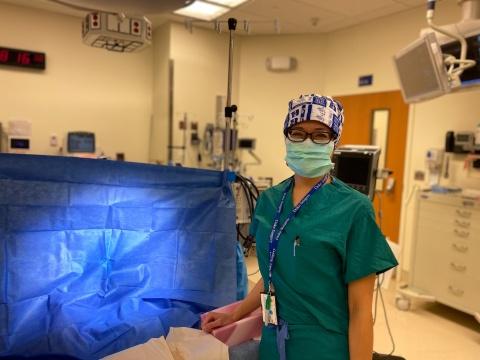
Photo above: Dr. Cecilia Ong, General Surgery Chief Resident, preps for surgery
For many healthcare professionals, news of the COVID-19 pandemic arrived from multiple channels and on many different levels: policies from their institutions, global news, CDC guidelines, and first-hand accounts from colleagues all over the world through social media. It has affected all areas of our lives, and one Duke resident offered her perspective on social media, workplace burnout, and the complications of patient care.
“Social media became a way for dissemination of information, and also of first-hand accounts of how the pandemic was affecting residents, trainees, and medical professionals at large,” said Cecilia Ong, MD, General Surgery Chief Resident. It has provided a window into what is happening in the epicenters of the pandemic in real time. Care teams not only follow personal accounts from individuals on the ground floor, but also keep up with news outlets and their own institutions’ policies, then try to repackage and translate all of that information for patients while they are in their most vulnerable states—before and after surgery.
“The way that Duke has responded as an institution, having the footprint that it has in the state of North Carolina, has been incredibly important in it setting the tone for how both our patients and, by diffusion, the rest of the community may have perceived the pandemic,” says Dr. Ong, who has been with Duke for over ten years, since she was a medical student.
She described her experience with a patient who tested COVID-19 positive post-surgery, while clarifying that her experience differed greatly from those who care for COVID-19–positive patients in the critical care setting. This patient had followed all preoperative procedures and the test came back negative, but they were retested post-surgery after showing symptoms, and the results came back positive.
“Not having easy access to our patients, not having the ability to freely go in and talk with them and especially their families, was a significant impediment to the patient experience and to patient care.”
-Dr. Cecilia Ong, General Surgery Chief Resident
“We all, throughout medical school and our training, hope to learn the skills of patient communication whereby we establish a shared notion of what the issues and the difficulties are, and if complications do occur, explaining them to the patient and coming to an individual understanding of why that’s happened and what the projected course is going to look like,” says Dr. Ong.
A positive test result for COVID-19 adds stress not just for patients and their families, but also for their care teams. Day-to-day patient care during recovery is already complex, and the added diagnosis complicates not just care, but also communication. “Not having easy access to our patients, not having the ability to freely go in and talk with them and especially their families, was a significant impediment to the patient experience and to patient care,” says Dr. Ong. “It’s not anything that we could have avoided, it’s just the nature of the beast.”
“[F]rom an anecdotal standpoint, the tutorials on donning and doffing were some of the most complex things that I’ve seen, […] it’s a dual challenge of getting over that inertia of dealing with your first COVID-positive patient while still maintaining the same level of heightened alertness to potential transmission and not wanting to put your other patients at risk,” says Dr. Ong. “We also want to make sure that we are all protecting each other. The main struggle is getting over that first sense of newness while still maintaining vigilance about the precautions.”
The rates of burnout in medical professions have increased far above the general rates pre-pandemic, in large part due to the added stress from the uncertainty of the situation. Residents like Dr. Ong prepared themselves for a surge, only to find that it became more of a sustained picture. Each residency program at Duke has worked to support its residents, from case postings to the best way to safely deploy residents. Duke administration has been very responsive, holding town halls to address concerns from staff, but according to Dr. Ong, there is still “this constant sense you’re on edge, but there’s not been that one identifiable thing that says this is going to be the end of it and you’re going to be able to go back to normal.”
For Dr. Ong, the silver lining of this experience has been the partnership between the hospitalist team and the other care teams within the hospital. "One thing I’ll speak to as being a positive from this is the openness to communication and shared decision-making with our surgical team."
Give to Duke Surgery
A gift to the Department of Surgery is a gift of knowledge, discovery, and life.